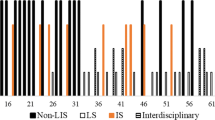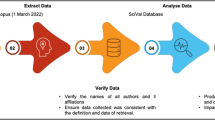Abstract
This study investigated the external contributors of library and information science (LIS) knowledge who were unaffiliated with LIS-related institutions but published their research results in LIS journals. Differences between the contributors to library science (LS) and contributors to information science (IS) were considered. Articles published in 39 strongly LIS-oriented journals indexed in the Web of Science database between 2005 and 2014 were analyzed. The results demonstrated that 46.5% of the LIS articles were written by at least one non-LIS author; authors’ backgrounds ranged across 29 disciplines. An increasing trend was observed in degrees of interdisciplinarity of LS and IS. An increase in proportion of articles by LIS and non-LIS authors was identified in LS and IS as well. Those with medical backgrounds were the primary non-LIS authors contributing to the LS field and collaborated the most frequently with LIS authors. Those with computer science backgrounds were the most prevalent non-LIS contributors to the IS field and preferred to publish individually. A critical difference was also identified in research topics between LS and IS. The foundations of LIS and scientometrics were the largest research topics in LS and IS, respectively.


Similar content being viewed by others
References
Abrizah, A., Noorhidawati, A., & Zainab, A. N. (2015). LIS journals categorization in the Journal Citation Report: A stated preference study. Scientometrics, 102(2), 1083–1099.
Aharony, N. (2012). Library and Information Science research areas: A content analysis of articles from the top 10 journals 2007-8. Journal of Librarianship and Information Science, 44(1), 27–35.
Alvargonzález, D. (2011). Multidisciplinarity, interdisciplinarity, transdisciplinarity, and the sciences. International Studies in the Philosophy of Science, 25(4), 387–403.
Åström, F. (2007). Changes in the LIS research front: Time-sliced cocitation analyses of LIS journal articles, 1990–2004. Journal of the American Society for Information Science and Technology, 58(7), 947–957.
Beattie, V., & Goodacre, A. (2004). Publishing patterns within the UK accounting and finance academic community. British Accounting Review, 36(1), 7–44.
Bellotti, E., Kronegger, L., & Guadalupi, L. (2016). The evolution of research collaboration within and across disciplines in Italian Academia. Scientometrics, 109(2), 783–811.
Bordons, M., Zulueta, M. A., Romero, F., & Barrigón, S. (1999). Measuring interdisciplinary collaboration within a university: The effects of the multidisciplinary research programme. Scientometrics, 46(3), 383–398.
Buttlar, L. (1999). Information sources in library and information science doctoral research. Library and Information Science Research, 21(2), 227–245.
Chang, Y. W. (2011). A comparative study of the research literature on information needs and information seeking: A bibliometric and social network analysis. Journal of Educational Media and Library Science, 48(3), 347–380.
Chang, Y. W., & Huang, M. H. (2012). A study of the evolution of interdisciplinarity in library and information science: Using three bibliometric methods. Journal of the American Society for Information Science and Technology, 63(1), 22–33.
Chang, Y. W., Huang, M. H., & Lin, C. W. (2015). Evolution of research subjects in library and information science based on keyword, bibliographical coupling, and co-citation analyses. Scientometrics, 105(3), 2071–2087.
Enger, K. B. (2015). Understanding the development of disciplines and the ways they contribute to knowledge and reflect practice: An analysis of articles published in higher education and library and information science. Advances in Library Administration and Organization, 24, 1–51.
Erfanmanesh, M. A., Didegah, F., & Omidvar, S. (2010). Research productivity and impact of library and information science in the web of science. Malaysian Journal of Library and Information Science, 15(3), 85–95.
Gonzalez-Alcaide, G., Castello-Cogollos, L., Navarro-Molina, C., Aleixandre-Benavent, R., & Valderrarna-Zurian, J. C. (2008). Library and information science research areas: Analysis of journal articles in LISA. Journal of the American Society for Information Science and Technology, 59(1), 150–154.
Hall, F. (2016). Digital change and industry responses: Exploring organizational and strategic issues in the book-publishing industry. Logos (Netherlands), 27(2), 19–31.
Hessey, R., & Willett, P. (2013). Quantifying the value of knowledge exports from librarianship and information science research. Journal of Information Science, 39(1), 141–150.
Huang, M. H., & Chang, Y. W. (2012). A comparative study of interdisciplinary changes between information science and library science. Scientometrics, 91(3), 789–803.
Jabeen, M., Yun, L., Rafiq, M., & Jabeen, M. (2015). Research productivity of library scholars bibliometric analysis of growth and trends of LIS publications. New Library World, 116(7–8), 433–454.
Klavans, R., & Boyack, K. W. (2011). Using global mapping to create more accurate document-level maps of research fields. Journal of the American Society for Information Science and Technology, 62(1), 1–18.
Levitt, J. M., Thelwall, M., & Oppenheim, C. (2011). Variations between subjects in the extent to which the social sciences have become more interdisciplinary. Journal of the American Society for Information Science and Technology, 62(6), 1118–1129.
Lugya, F. K. (2014). What counts as a science and discipline in library and information science? Library Review, 63(1/2), 138–155.
Milojević, S., Sugimoto, C. R., Yan, E., & Ding, Y. (2011). The cognitive structure of library and information science: Analysis of article title words. Journal of the American Society for Information Science and Technology, 62(10), 1933–1953.
Mondal, D., Kanamadi, S., & Das, K. (2017). Contribution by Indian authors in foreign origin library and information science journals during 2006–2015: A scientometrics study. DESIDOC Journal of Library and Information Technology, 37(6), 396–402.
Moya-Anegón, F., Herrero-Solana, V., & Jiménez-Contreras, E. (2006). A connectionist and multivariate approach to science maps: The SOM, clustering and MDS applied to library and information science research. Journal of Information Science, 32(1), 63–77.
Ni, C., Sugimoto, C. R., & Cronin, B. (2013). Visualizing and comparing four facets of scholarly communication: Producers, artifacts, concepts, and gatekeepers. Scientometrics, 94(3), 1161–1173.
Odell, J., & Gabbard, R. (2008). The interdisciplinary influence of library and information science 1996–2004: A journal-to-journal citation analysis. College and Research Libraries, 69(6), 546–565.
Paul-Hus, A., Mongeon, P., & Shu, F. (2016). Portraying the landscape of Canadian library and information science research. Canadian Journal of Information and Library Science, 40(4), 332–346.
Pierce, S. J. (1999). Boundary crossing in research literatures as a means of interdisciplinary information transfer. Journal of the American Society for Information Science, 50(3), 271–279.
Porter, A. L., & Rafols, I. (2009). Is science becoming more interdisciplinary? Measuring and mapping six research fields over time. Scientometrics, 81(3), 719–745.
Prebor, G. (2010). Analysis of the interdisciplinary nature of library and information science. Journal of Librarianship and Information Science, 42(4), 256–267.
Qiu, L. (1992). A study of interdisciplinary research collaboration. Research Evaluation, 2(3), 169–175.
Rafols, I., & Meyer, M. (2010). Diversity and network coherence as indicators of interdisciplinarity: Case studies in bionanoscience. Scientometrics, 82(2), 263–287.
Rodionov, I. I., & Tsvetkova, V. A. (2015). Information management in information science. Scientific and Technical Information Processing, 42(2), 73–77.
Rodriguez, J. M. (2017). Disciplinarity and interdisciplinarity in citation and reference dimensions: Knowledge importation and exportation taxonomy of journals. Scientometrics, 110(2), 617–642.
Sǎvoiu, G. (2014). The impact of inter-, trans-and multidisciplinarity on modern taxonomy of sciences. Current Science, 106(5), 685–690.
Shu, F., Larivière, V., Mongeon, P., Julien, C. A., & Piper, A. (2016). On the evolution of library and information science doctoral dissertation topics in north America 1960–2013. Journal of Education for Library and Information Science, 57(2), 131–142.
Spellerberg, I. F., & Fedor, P. J. (2003). A tribute to Claude Shannon (1916–2001) and a plea for more rigorous use of species richness, species diversity and the ‘Shannon-Wiener’ Index. Global Ecology and Biogeography, 12(3), 177–179.
Sugimoto, C. R., Li, D., Russell, T. G., Finlay, S. C., & Ding, Y. (2011). The shifting sands of disciplinary development: Analyzing North American library and information science dissertations using latent Dirichlet allocation. Journal of the American Society for Information Science and Technology, 62(1), 185–204.
Tuomaala, O., Jarvelin, K., & Vakkari, P. (2014). Evolution of library and information science, 1965–2005: Content analysis of journal articles. Journal of the Association for Information Science and Technology, 65(7), 1446–1462.
Tveit, A. K. (2017). A celebration of diversity: LIS research in the Nordic countries as shown by PhD dissertations 2005–2014. Journal of Education for Library and Information Science, 58(2), 64–76.
Walters, W. H., & Wilder, E. I. (2016). Disciplinary, national, and departmental contributions to the literature of library and information science, 2007–2012. Journal of the Association for Information Science and Technology, 67(6), 1487–1506.
Wang, F., & Wolfram, D. (2015). Assessment of journal similarity based on citing discipline analysis. Journal of the Association for Information Science and Technology, 66(6), 1189–1198.
Xiao, X., Zhang, F., & Li, J. (2015). Library and information science research in China: A survey based analysis of 10 LIS educational institutes. Journal of Academic Librarianship, 41(3), 330–340.
Yan, E. (2014). Research dynamics: Measuring the continuity and popularity of research topics. Journal of Informetrics, 8(1), 98–110.
Yan, E. (2016). Disciplinary knowledge production and diffusion in science. Journal of the Association for Information Science and Technology, 67(9), 2223–2245.
Yang, S., Han, R., Wolfram, D., & Zhao, Y. (2016). Visualizing the intellectual structure of information science (2006–2015): Introducing author keyword coupling analysis. Journal of Informetrics, 10(1), 132–150.
Zhang, J. (2017). The integration of technology and the publishing industry in China. Publishing Research Quarterly, 33(2), 173–182.
Zhao, D., & Strotmann, A. (2014). The knowledge base and research front of information science 2006–2010: An author cocitation and bibliographic coupling analysis. Journal of the Association for Information Science and Technology, 65(5), 995–1006.
Acknowledgements
This research was financially supported by a grant from the Ministry of Science and Technology of Taiwan (MOST 105-2410-H-002-117) and by the Center for Research in Econometric Theory and Applications (Grant no. 107L900204 ) from The Featured Areas Research Center Program within the framework of the Higher Education Sprout Project by the Ministry of Education (MOE) in Taiwan, and by the Ministry of Science and Technology (MOST), Taiwan, under Grant No. MOST 107-3017-F-002-004-.
Author information
Authors and Affiliations
Corresponding author
Rights and permissions
About this article
Cite this article
Chang, YW. Examining interdisciplinarity of library and information science (LIS) based on LIS articles contributed by non-LIS authors. Scientometrics 116, 1589–1613 (2018). https://doi.org/10.1007/s11192-018-2822-7
Received:
Published:
Issue Date:
DOI: https://doi.org/10.1007/s11192-018-2822-7




